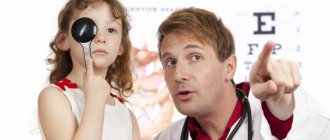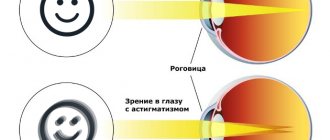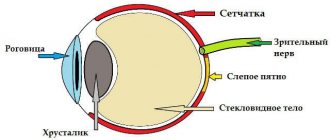Mild hyperopia in childhood is considered normal.
Then the child grows up, the optical system of the eye adapts, the disorder disappears or takes on a hidden form.
It is difficult to diagnose it in an adult, since there are no acute symptoms. If farsightedness is not treated, distance vision will also deteriorate. There are indirect signs by which one can suspect the condition. Mild hypermetropia is corrected with glasses.
We recommend reading: Farsightedness - is it a plus or a minus?
What is farsightedness
Farsightedness is poor near vision but good distance vision. The disorder in young and middle age is referred to as hypermetropia. It occurs due to the structural features of the eyeball.
The cornea and lens are involved in image formation. Normally, rays penetrate through the lens into the chamber of the eye and are focused at a point on the retina. In hypermetropia, the lens refracts light behind the retina. This is caused by its low refractive ability and backward displacement. In addition, light does not reach the retina due to the short eyeball. Normally its shape is spherical. An eye with hypermetropia is flattened anteriorly and posteriorly.
The ciliary muscle dilates and constricts the pupil. This regulates the amount of light entering the eye chamber. With weak farsightedness, the work of the muscle compensates for the incorrect distribution of light over refractive surfaces. Clarity of vision is achieved through muscle action rather than natural reflection. Since muscles tend to get tired, a spasm of accommodation, tension headaches, and photosensitivity develop over time. The muscle cannot adjust focus and vision deteriorates.
Farsightedness was discovered. What's next?
Different types of hypermetropia require different treatment approaches. Therefore, it is better to entrust the choice of treatment tactics to an ophthalmologist. So if you or your child are diagnosed with farsightedness, go to the doctor without delay. The specialist will explain what needs to be done in your specific case.
Treatment of age-related farsightedness
Senile farsightedness cannot be cured. The disease is caused by irreversible changes in the lens and ciliary body, which cannot be corrected. Over time, they progress, and vision deteriorates.
So what to do in this case?
The safest, time-tested, reverse way to correct farsightedness is correction with glasses, and the combination of glasses with contact lenses will provide not only high vision and comfort.
In the initial stages of presbyopia, a person only needs reading glasses, which he puts on if necessary. In the future, he may need multifocal glasses to wear constantly.
Correct spectacle correction increases visual acuity up to 100%. Thanks to this, a person can easily read, embroider, work on a computer, etc. In people who wear glasses, asthenopic phenomena completely disappear. Moreover, such people no longer suffer from chronic blepharitis and chalazions.
To correct presbyopia, glasses with positive single vision lenses are used. The former are only suitable for reading, while others can be worn throughout the day. Multifocal glasses are usually needed by people who have visual impairments at both close and long distances, as well as who have fairly dynamic vision at close and medium distances: they need to very quickly change different ways of receiving information - simultaneously write, read texts, work with gadgets, look at the phone and so on. If you lead an active lifestyle, want to be competitive in your profession for a long time, restrain the progression of presbyopia, get aesthetic glasses without hints of age - definitely consider the options of multifocal lenses for glasses, as well as multifocal soft contact lenses.
Treatment of farsightedness in children
Children with farsightedness need adequate glasses correction. It helps maintain binocular vision, as well as avoid the development of strabismus and amblyopia. Along with this, children are prescribed hardware treatment and physiotherapeutic procedures.
If by the age of 6-7 years the baby has not developed strabismus, he is allowed to take off his glasses. After 18 years of age, a child can undergo laser vision correction.
Hypermetropia: treatment with surgical methods
To restore vision in case of farsightedness, it is necessary to shift the main focus to the retina. To do this, you need to change the refractive power of the eyeball.
Nowadays, this can be done in one of two ways:
- By changing the thickness of the cornea
. For this purpose, laser vision correction is performed. The technique is used only at a young age. It is not suitable for the treatment of presbyopia.
- Replacing the lens.
Refractive lens replacement is performed for age-related farsightedness. Please note that this operation is associated with some risks and complications.
Lens replacement surgery is not cheap. Therefore, nowadays people with farsightedness prefer glasses or contact lenses.
Degrees of hypermetropia
Degrees of farsightedness according to the nature of the disorder:
- weak - there are no visible deviations, rapid eye fatigue is noted;
- medium - noticeable deterioration when looking at close objects;
- high - a person sees poorly near and far.
Correspondence of diopters to degrees:
- up to +2 - weak;
- +2 – +5 – average;
- above +5 - high.
Mild hypermetropia in both eyes does not cause noticeable discomfort. It can only be diagnosed by chance. When a patient complains of poor vision when reading, farsightedness has already become moderate. But ophthalmologists have identified the symptoms by which the initial stage of farsightedness is recognized.
Important to remember
Early diagnosis and adequate correction of farsightedness help to avoid many troubles. The sooner you see a doctor, the less chance you have of getting unwanted complications.
You can undergo an examination and consult with an ophthalmologist at the nearest Luxoptika branch. The doctor will find out whether you have farsightedness and give the necessary recommendations. If necessary, he will write you a prescription with which you can buy glasses or contact lenses.
If you have any questions or would like to make an appointment with a doctor, call 0.
Symptoms
Characteristic signs that are difficult to associate with hypermetropia:
- Work that requires perseverance and attention causes tension headaches, there is debris in the eyes, the person begins to rub them, gets distracted, and has difficulty reading large texts and writing. This is especially noticeable in children. They get tired quickly, experience unconscious discomfort and therefore study poorly.
- Chronic conjunctivitis, inflammation of the mucous membranes of the eyelids.
- Sometimes it is difficult to see small objects.
- Frequent headaches and dizziness.
- When working at a computer, dry and tired eyes syndrome quickly develops.
Symptoms of mild hypermetropia with astigmatism:
- the contours of the object become blurred as they gradually approach;
- the image appears double.
If you feel obvious fatigue after reading, watching TV, working at a monitor or using gadgets, you need to have your vision checked by an ophthalmologist. At the next attack of conjunctivitis, you should also not limit yourself to self-medication with proven remedies, but undergo diagnostics.
Symptoms of farsightedness
How to determine farsightedness? You need to start with the symptoms. First, hypermetropes have deteriorating near vision. Objects located nearby seem blurry and indistinct to them. It becomes difficult for such people to read newspapers, work on a computer, and even distinguish text on a mobile phone screen. Over time, their distance visual acuity decreases.
Hypermetropia forces a person to constantly strain their eyes. He squints all the time in an attempt to focus his gaze on nearby objects. This causes the development of accommodative asthenopia.
Its symptoms:
- increased visual fatigue;
- frequent watery eyes and redness of the eyes;
- periodic blurred vision;
- regular headaches;
- feeling of fullness in the eye area.
The appearance of these symptoms allows one to suspect farsightedness. Only an ophthalmologist can confirm the diagnosis. To do this, he needs to examine the patient, check his visual acuity, and do refractometry. Only after this the specialist will give recommendations and select the necessary correction.
People with myopia experience the first signs of farsightedness later than others. As a rule, their disease manifests itself at the age of 45-50 years.
Diagnostics
Some methods can help identify mild hypermetropia.
Visometry
Includes vision testing using symbol tables:
- Sivtsev's tables are rows with letters of different sizes, decreasing from top to bottom. In the children's version, letters replace images of animals and objects that the child knows and names. A stand with a table hangs on the wall. Normal - 9-10 lines are clearly visible at a distance of 5 meters. A person with farsightedness reads the letters of the 11th-12th lines, being far from the table, and does not clearly see the large letters of the first lines, approaching the stand.
- Golovin's table - the principle is the same, the image is reduced from top to bottom. Instead of letters and images, the lines consist of circles with cuts in different places. The table is rarely used to exclude simulation. The sequence of cuts on circles is more difficult to remember.
Before carrying out the following methods, drops are instilled into the eyes to dilate the pupils.
Skiascopy
A skiascope is an instrument with a rotating mirror surface that directs a beam of light into the eyes. The experiment examines the refractive ability of the ciliary muscle.
Diagnostic methods also include:
- Computer refractometry is an improved skiascopy. The mirror was replaced by a device that automatically produces the result of the experiment.
- Perimetry - determination of the width of the field of view. Helps to recognize pathologies of the optic nerve and retina.
- Ophthalmoscopy is a study of the state of the circulatory system of the eyeball.
- Biomicroscopy - using a slit lamp. The device consists of a binocular microscope and a lamp that directs a thin beam of light into the eyes. The method also determines pathologies of the retina, blood vessels and optic nerve.
If deviations are detected, tonometry is done - measuring eye pressure. Additionally, magnetic resonance imaging and ultrasound are used. Using MRI and ultrasound, a model of the eyeball is obtained that reflects the condition of the fundus and blood vessels.
The vascular network is also examined using fluorescein angiography.
For a reliable diagnosis, you should undergo a comprehensive examination. The treatment plan depends on the presence or absence of concomitant pathologies.
Degrees of development of hypermetropic astigmatism
Doctors distinguish different degrees of development of hypermetropic astigmatism. This indicator allows you to determine the refraction value of rays.
Traditionally, ophthalmologists distinguish the following degrees of the disease:
- Weak degree is the most common variant of the disease. It responds well to conservative therapy.
- Moderate hypermetropia is a less common dysfunction.
- High degree hypermetropia develops due to serious pathologies in the cornea.
The higher the degree of the disease is diagnosed, the more complex the treatment will be. As soon as the first symptoms of a problem are identified, you should immediately visit an ophthalmologist. The specialist will perform a series of diagnostic examinations, based on which he will prescribe an adequate therapeutic course.
The patient must scrupulously follow the doctors' recommendations to ensure vision restoration.
Treatment
Weak farsightedness is corrected using the following methods:
Using optics
The ophthalmologist selects glasses or contact lenses.
Benefits of glasses:
- affordable price;
- a variety of frames to choose from;
- lack of eye contact;
- Ease of use;
- ease of care.
Contact lenses are rarely chosen to correct farsightedness. They provide a wider view and clearer images. But you need to learn how to put them on and take care of them. For weak hypermetropia, the process is too labor-intensive.
You can buy ready-made glasses without the help of an ophthalmologist. But glasses made according to a doctor’s prescription are more effective, as they meet individual parameters. In ready-made glasses, a person will see well, but his eyes will still get tired.
Physiotherapy
Procedures to help relieve tension in the eye muscles:
- phonophoresis - ultrasound treatment, therapeutic baths;
- color therapy - exposure to rays of different colors;
- pneumomassage using Sidorenko hardware glasses.
The methods will help reduce the impact of concomitant disorders: reduce eye pressure, manifestation of the vascular network, alleviate inflammation of the optic nerve.
Eye drops
Overstrain of the ciliary muscle can be relieved by medications that dilate the pupil. They are dripped before going to bed, as under their influence vision becomes blurry. Overnight, the effect of the drops goes away, along with muscle spasms.
Gymnastics
Exercises include:
- Movements with the eyes - down, up, left, right, diagonally, describing an imaginary figure eight with the eyes.
- Focus training - selects near and far objects located on the same line. You need to alternately look from one to the other. The second exercise is to extend your arm forward with your thumb raised. Looking at the finger, gradually bring your hand closer.
- Palming - close your eyes with your palms, leaving space between them. The warmth of your hands and the darkness have a relaxing effect.
Gymnastics for the eyes
If complications are detected with a weak degree of hypermetropia, lens clouding, accommodative asthenopia, laser correction is possible. But operational methods are not a priority. Only at the request of the patient and in the absence of contraindications.
Children's farsightedness
Healthy newborn children have hypermetropic refraction. Normally, all children in the first years of life have farsightedness of 2-3 diopters. As they age, their vision stabilizes. And by the age of 5-7 years, most children develop emmetropic, that is, normal refraction.
When should farsightedness in children cause concern?
You should worry in the following cases:
- if doctors have detected hypermetropia of more than 3-4 diopters in a baby in the first year of life;
- if farsightedness does not go away over time, that is, it persists at school age.
Physiological hypermetropia does not require treatment. It does not harm the child and goes away on its own without any consequences.
But children with pathological farsightedness need optical correction with glasses or contact lenses. In its absence, children develop convergent strabismus, and subsequently amblyopia.
Amblyopia is a dangerous disease in which a child’s vision is irreversibly impaired. It develops due to the inactivity of the eye and disruption of its relationship with the brain. Curing amblyopia is extremely difficult, and sometimes even impossible.
Prevention
To prevent farsightedness from developing, you need to follow the rules:
- do not illuminate the work area with fluorescent lamps;
- read in good lighting;
- observe work and rest hours at the computer;
- be examined by an ophthalmologist once every six months;
- include foods with vitamins A, C, and B in your diet.
Good sleep is important for eye health.
We recommend reading: Preventing farsightedness
Will gymnastics help?
Have you heard or read about miracle treatments for hypermetropia? Well, we will disappoint you. Eye exercises for farsightedness usually do not give the expected results. Some of them temporarily improve vision, but the effect disappears immediately after the person stops exercising.
Note that eye vitamins are also useless. Therefore, there is no point in using them for the treatment and prevention of farsightedness. As a rule, the prescription of dietary supplements and multivitamin complexes coincides with the prescription of presbyopia correction. Doctors do this not with the goal of curing presbyopia or helping its progression, but in order to support the retina, reduce the negative effects of free radicals, blue light, ultraviolet rays, improve metabolic processes, and compensate for the lack of vitamins and minerals associated with insufficient or improper nutrition.
Treatment of hyperopic astigmatism
Based on examination data, the degree of damage and the individual characteristics of the body, the doctor chooses an effective treatment for hypermetropic astigmatism.
If the disease is detected at the very beginning of its development, when the problem is mild, the patient is prescribed vision correction. For this purpose, glasses or contact lenses are used. These methods help correct vision and restore its sharpness.
An ophthalmologist will tell you how to use this device correctly. To restore vision, doctors recommend astigmatic lenses.
They come in two types:
- hard;
- flexible.
Lenses are negative or positive. The correct structure of these products helps to change the direction of light, which is focused in the required areas of the eyeball. Through this change, the error in the visual organ is corrected. Glasses are prescribed for illness in childhood.
Constantly wearing these lenses helps prevent strabismus. All these treatment methods effectively correct visual acuity. For this reason, such therapeutic options are resorted to in the early stages of pathology.
Surgical intervention
In more severe cases, as well as in order to completely get rid of farsighted astigmatism, surgical actions are required to correct the shape of the cornea. Such operations are performed by doctors specializing in microsurgery.
The most effective methods of influencing the cornea are recognized:
- Laser thermokeratoplasty.
- Laser keratomileusis.
With the help of these measures, you can change not only the shape of the cornea, making it convex-flat in the central part, but also quickly restore visual acuity. Sometimes such treatment cannot be carried out.
Prevention of hypermetropic astigmatism
In most cases, hypermetropic astigmatism in children is a congenital defect. For this reason, prevention of pathology should be carried out from an early age.
For this purpose it is necessary:
- Perform special eye exercises to strengthen the eye muscles. These are glances in different directions and circular movements of the eyeballs, slow blinking.
- Choose the right lighting mode for the workplace area.
- Play sports (running and swimming).
- Organize hardening procedures.
- Provide a balanced diet.
- Perform eyelid massage.
Complications of hyperopic astigmatism
Hypermetropic astigmatism in children often causes the development of strabismus. Such a negative change appears against the background of a difference in refractive power, which is more than 1.5 diopters. It develops simultaneously in the right and left eyes.
If this pathology is not treated, then after reaching the age of 10 the child will develop strabismus.
Such changes cause unpleasant sensations in a teenager, being a cosmetic defect that can cause psychological problems.
Regular examination of the child by an ophthalmologist will help avoid this phenomenon. The main task of parents is to follow all the recommendations of the ophthalmologist.











